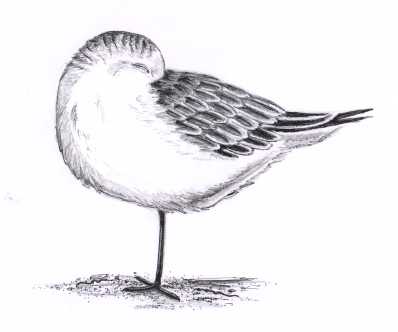
Dear Bird Folks,
Once again I turn to the bird guru for a profound answer to this serious question. How and where do birds sleep? Do you have any pictures of them sleeping?
Dick, Chatham
Say What Dick:
A guru? You think I’m a guru? Wait until the kids from the old neighborhood find out that I’ve become a guru.
Sleep for birds is quite a bit different than it is for us. Birds don’t have the eight hour, dead-to-the-world snore fest like we do. Birds are totally light sleepers, they rarely fall into any kind of deep sleep at all. Most of us are able to sleep soundly without much fear of being eaten. But birds must be constantly aware of their surroundings, keeping an ear alert for danger, ready to hop out of bed and move on at a moment’s notice. Short little bursts of sleep are the best that many of them can hope for.
Where do birds sleep? Birds typically roost in the same type of habitat that they nest and feed in. Ducks sleep in or near water, shorebirds sleep on the beach, cardinals sleep in bushes, and woodpeckers sleep in, of all places, woodpecker holes. I’m not sure what bird you had in mind when you asked this question, Dick, but whatever bird it was, think about where it lives and that is where it will probably roost. The pigeons of Provincetown eat and sleep right in the middle of town. They don’t fly to Race Point Beach to go to sleep. And the sandpipers of the beach don’t fly to the roof of the Town Hall to spend the night. The one exception is those flamingos that leave the area wetlands to spend each night in front of that restaurant in Brewster.
As for how they sleep, most birds use the old “wing tuck” method. Actually, birds don’t tuck their heads under their wing. Instead they rest their heads on their backs while they nuzzle their beaks into their back feathers. Sleeping with their head tucked on their back allows birds to rest their neck muscles and also makes for better heat conservation.
Quail have another way of roosting. Bobwhites will huddle together on the ground in a tight circle. They keep their heads facing out so they are ready for a quick get-away. Sea ducks sleep while bobbing around in the open ocean. And most shorebirds spend the night on outer beaches with their heads tucked on their backs, while they sleep standing on one leg. (Don’t ask about the one leg thing, Dick, let’s save that question for someone else.)
Like most things in the bird world, there are a few freak birds that do something totally off the wall. Some parrots cling to branches upside down, sleeping like bats. Some swifts never land, except to breed. Most of the year swifts continue to fly non-stop day and night. It is commonly thought that swifts sleep on the wing. And giraffes sleep less than 30 minutes a day. I know that last fact has nothing to do with birds, but where else can I use that odd piece of information?
Thanks for the question, Dick, and thanks for thinking I’m a guru. However, I can’t supply you with any pictures of birds sleeping. You’ll probably have to go to some weird late night web site to find those kinds of pictures.
On another subject, molting, molting, molting. That’s right, molting. All the weird, bald, crestless, blotchy birds that we are seeing are molting. They molt at the same time every year and this year is no different. Stop writing, calling and worrying. The birds will all be fine. If you’re going to worry about anything, worry about the Red Sox. They do their own kind of molting every year about this time.